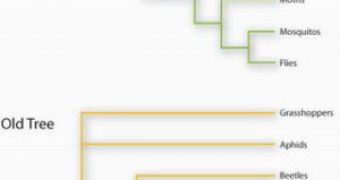Genetic analysis effectuated on insects from various orders led to redrawing the insect family tree. The researchers have discovered that flies, mosquitoes, moths and butterflies are more closely related to beetles than to bees and wasps, as previously thought.
The team focused on 185 genes found in the genomes of eight insect families. Evolutionary relationships between insect groups were established from mutations within these genes.
This new genetic data also brings closer the different taxonomic groups of social insects, like termites and bees. This could mean that the capacity of insects to organize in social groupings may have appeared just once, rather than independently many times. "While there was never unequivocal evidence for it, scientists believed for a long time that, based on morphology, flies and moths were most closely related to bees, with beetles more distantly related to these three groups" said Dr Martin Lercher from the University of Bath.
"This (research) sheds new light on a large number of evolutionary questions, as a correct understanding of the evolutionary relationships is fundamental to any interpretation of similarities or differences among species."
"For example, social colonies are common among bees and wasps and their relatives, ants, as well as among more distantly related insects, such as termites and aphids."
"That beetles don't show this tendency, known as eusociality, has been interpreted as a sign that eusociality has evolved several times independently."
"Now that we know that bees, wasps and ants are in fact the closest relatives to the more distantly related (or 'basal') species, it appears more likely that the genetic basis for eusociality may have evolved only once, and was lost in the common ancestor of beetles, moths, and flies."
The study was made on four different insects orders of holometabolous insects (insects which undergo complete metamorphosis: larvae completely distinct from adult, a pupal immobile stage and adult, also called imago): fruit fly (Drosophila melanogaster), mosquito (Anopheles gambiae), silk moth (Bombyx mori), flour beetle (Tribolium castaneum), honey bee (Apis mellifera) and sibling parasitic wasp species (Nasonia vitripennis and Nasonia giraulti).
Beetles form Order Coleoptera ("sheathed wing"), moths and butterflies form Order Lepidoptera ("scaly wing"), flies and mosquitoes form Order Diptera (two wings") and bees and wasps form Order Hymenoptera ("membrane wing").
Together these orders account for 45 % of all animal species. The study also focused on one Orthoptera (the grasshopper Locusta migratoria) and one Hemiptera (the pea aphid Acyrthosiphon pisum), from clearly distant groups holometabolous insects (insects with incomplete metamorphosis: larvae resembling wingless adults and without pupal immobile stage).
Image credit: University of Bath

 14 DAY TRIAL //
14 DAY TRIAL //